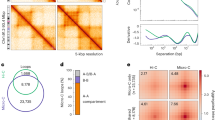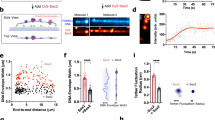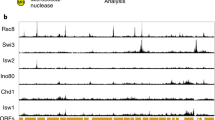Abstract
Because RNA polymerase is a powerful motor, transmission of transcription-generated forces might directly alter DNA structure, chromatin or gene activity in mammalian cells. Here we show that transcription-generated supercoils streaming dynamically from active promoters have considerable consequences for DNA structure and function in cells. Using a tamoxifen-activatable Cre recombinase to excise a test segment of chromatin positioned between divergently transcribed metallothionein-IIa promoters, we found the degree of dynamic supercoiling to increase as transcription intensified, and it was very sensitive to the specific arrangement of promoters and cis elements. Using psoralen as an in vivo probe confirmed that, during transcription, sufficient supercoiling is produced to enable transitions to conformations other than B-DNA in elements such as the human MYC far upstream element (FUSE), which in turn recruit structure-sensitive regulatory proteins, such as FUSE Binding Protein (FBP) and FBP-Interacting Repressor (FIR). These results indicate that mechanical stresses, constrained by architectural features of DNA and chromatin, may broadly contribute to gene regulation.
This is a preview of subscription content, access via your institution
Access options
Subscribe to this journal
Receive 12 print issues and online access
$189.00 per year
only $15.75 per issue
Buy this article
- Purchase on Springer Link
- Instant access to full article PDF
Prices may be subject to local taxes which are calculated during checkout








Similar content being viewed by others
References
Sinden, R.R. DNA Structure and Function (Academic Press, San Diego, 1994).
Kouzine, F. & Levens, D. Supercoil-driven DNA structures regulate genetic transactions. Front. Biosci. 12, 4409–4423 (2007).
Peter, B.J. et al. Genomic transcriptional response to loss of chromosomal supercoiling in Escherichia coli. Genome Biol. [online] 5, R87 (2004).
Lim, H.M., Lewis, D.E., Lee, H.J., Liu, M. & Adhya, S. Effect of varying the supercoiling of DNA on transcription and its regulation. Biochemistry 42, 10718–10725 (2003).
Travers, A. & Muskhelishvili, G. DNA supercoiling—a global transcriptional regulator for enterobacterial growth? Nat. Rev. Microbiol. 3, 157–169 (2005).
Champoux, J.J. DNA topoisomerases: structure, function, and mechanism. Annu. Rev. Biochem. 70, 369–413 (2001).
Droge, P. Protein tracking-induced supercoiling of DNA: a tool to regulate DNA transactions in vivo? Bioessays 16, 91–99 (1994).
Wang, M.D. et al. Force and velocity measured for single molecules of RNA polymerase. Science 282, 902–907 (1998).
Chen, C.C. & Wu, H.Y. Transcription-driven DNA supercoiling and gene expression control. Front. Biosci. 8, d430–d439 (2003).
Kouzine, F., Liu, J., Sanford, S., Chung, H.J. & Levens, D. The dynamic response of upstream DNA to transcription-generated torsional stress. Nat. Struct. Mol. Biol. 11, 1092–1100 (2004).
Wang, Z. & Droge, P. Differential control of transcription-induced and overall DNA supercoiling by eukaryotic topoisomerases in vitro. EMBO J. 15, 581–589 (1996).
Koster, D.A., Croquette, V., Dekker, C., Shuman, S. & Dekker, N.H. Friction and torque govern the relaxation of DNA supercoils by eukaryotic topoisomerase IB. Nature 434, 671–674 (2005).
Darzacq, X. et al. In vivo dynamics of RNA polymerase II transcription. Nat. Struct. Mol. Biol. 14, 796–806 (2007).
Li, G., Levitus, M., Bustamante, C. & Widom, J. Rapid spontaneous accessibility of nucleosomal DNA. Nat. Struct. Mol. Biol. 12, 46–53 (2005).
Bancaud, A. et al. Structural plasticity of single chromatin fibers revealed by torsional manipulation. Nat. Struct. Mol. Biol. 13, 444–450 (2006).
van Holde, K. & Zlatanova, J. Unusual DNA structures, chromatin and transcription. Bioessays 16, 59–68 (1994).
Liu, J. et al. The FUSE/FBP/FIR/TFIIH system is a molecular machine programming a pulse of c-myc expression. EMBO J. 25, 2119–2130 (2006).
Tomonaga, T. et al. Unrestraining genetic processes with a protein-DNA hinge. Mol. Cell 1, 759–764 (1998).
Liu, H., Mulholland, N., Fu, H. & Zhao, K. Cooperative activity of BRG1 and Z-DNA formation in chromatin remodeling. Mol. Cell. Biol. 26, 2550–2559 (2006).
Boeger, H., Griesenbeck, J., Strattan, J.S. & Kornberg, R.D. Nucleosomes unfold completely at a transcriptionally active promoter. Mol. Cell 11, 1587–1598 (2003).
Lutter, L.C., Judis, L. & Paretti, R.F. Effects of histone acetylation on chromatin topology in vivo. Mol. Cell. Biol. 12, 5004–5014 (1992).
Norton, V.G., Marvin, K.W., Yau, P. & Bradbury, E.M. Nucleosome linking number change controlled by acetylation of histones H3 and H4. J. Biol. Chem. 265, 19848–19852 (1990).
Li, C.J., Averboukh, L. & Pardee, A.B. β-Lapachone, a novel DNA topoisomerase I inhibitor with a mode of action different from camptothecin. J. Biol. Chem. 268, 22463–22468 (1993).
Krishnan, P. & Bastow, K.F. Novel mechanism of cellular DNA topoisomerase II inhibition by the pyranonaphthoquinone derivatives α-lapachone and β-lapachone. Cancer Chemother. Pharmacol. 47, 187–198 (2001).
Frohlich, R.F. et al. Inhibition of Flp recombinase by the topoisomerase I-targeting drugs, camptothecin and NSC-314622. J. Biol. Chem. 276, 6993–6997 (2001).
Fujimoto, D.F., Pinilla, C. & Segall, A.M. New peptide inhibitors of type IB topoisomerases: similarities and differences vis-a-vis inhibitors of tyrosine recombinases. J. Mol. Biol. 363, 891–907 (2006).
Pommier, Y. Topoisomerase I inhibitors: camptothecins and beyond. Nat. Rev. Cancer 6, 789–802 (2006).
Vogelauer, M. & Camilloni, G. Site-specific in vivo cleavages by DNA topoisomerase I in the regulatory regions of the 35 S rRNA in Saccharomyces cerevisiae are transcription independent. J. Mol. Biol. 293, 19–28 (1999).
Jupe, E.R., Sinden, R.R. & Cartwright, I.L. Stably maintained microdomain of localized unrestrained supercoiling at a Drosophila heat shock gene locus. EMBO J. 12, 1067–1075 (1993).
Jupe, E.R., Sinden, R.R. & Cartwright, I.L. Specialized chromatin structure domain boundary elements flanking a Drosophila heat shock gene locus are under torsional strain in vivo. Biochemistry 34, 2628–2633 (1995).
Sinden, R.R., Carlson, J.O. & Pettijohn, D.E. Torsional tension in the DNA double helix measured with trimethylpsoralen in living E. coli cells: analogous measurements in insect and human cells. Cell 21, 773–783 (1980).
He, L. et al. Loss of FBP function arrests cellular proliferation and extinguishes c-myc expression. EMBO J. 19, 1034–1044 (2000).
Liu, J. et al. The FBP interacting repressor targets TFIIH to inhibit activated transcription. Mol. Cell 5, 331–341 (2000).
Weinmann, A.S. & Farnham, P.J. Identification of unknown target genes of human transcription factors using chromatin immunoprecipitation. Methods 26, 37–47 (2002).
Cai, S., Han, H.J. & Kohwi-Shigematsu, T. Tissue-specific nuclear architecture and gene expression regulated by SATB1. Nat. Genet. 34, 42–51 (2003).
Coulon, V. et al. A novel calcium signaling pathway targets the c-fos intragenic transcriptional pausing site. J. Biol. Chem. 274, 30439–30446 (1999).
Trinklein, N.D. et al. An abundance of bidirectional promoters in the human genome. Genome Res. 14, 62–66 (2004).
Bi, C. & Benham, C.J. WebSIDD: server for predicting stress-induced duplex destabilized (SIDD) sites in superhelical DNA. Bioinformatics 20, 1477–1479 (2004).
Kramer, P.R. & Sinden, R.R. Measurement of unrestrained negative supercoiling and topological domain size in living human cells. Biochemistry 36, 3151–3158 (1997).
Liang, C.P. & Garrard, W.T. Template topology and transcription: chromatin templates relaxed by localized linearization are transcriptionally active in yeast. Mol. Cell. Biol. 17, 2825–2834 (1997).
Chung, H.J. & Levens, D. c-myc expression: keep the noise down!. Mol. Cells 20, 157–166 (2005).
Michelotti, E.F., Sanford, S. & Levens, D. Marking of active genes on mitotic chromosomes. Nature 388, 895–899 (1997).
Rothenburg, S., Koch-Nolte, F. & Haag, F. DNA methylation and Z-DNA formation as mediators of quantitative differences in the expression of alleles. Immunol. Rev. 184, 286–298 (2001).
Michelotti, E.F., Tomonaga, T., Krutzsch, H. & Levens, D. Cellular nucleic acid binding protein regulates the CT element of the human c-myc protooncogene. J. Biol. Chem. 270, 9494–9499 (1995).
Espinas, M.L., Jimenez-Garcia, E., Martinez-Balbas, A. & Azorin, F. Formation of triple-stranded DNA at d(GA.TC)n sequences prevents nucleosome assembly and is hindered by nucleosomes. J. Biol. Chem. 271, 31807–31812 (1996).
Wong, B., Chen, S., Kwon, J.A. & Rich, A. Characterization of Z-DNA as a nucleosome-boundary element in yeast Saccharomyces cerevisiae. Proc. Natl. Acad. Sci. USA 104, 2229–2234 (2007).
Blank, T.A. & Becker, P.B. The effect of nucleosome phasing sequences and DNA topology on nucleosome spacing. J. Mol. Biol. 260, 1–8 (1996).
Levchenko, V., Jackson, B. & Jackson, V. Histone release during transcription: displacement of the two H2A–H2B dimers in the nucleosome is dependent on different levels of transcription-induced positive stress. Biochemistry 44, 5357–5372 (2005).
Peterson, C.L. Chromatin remodeling: nucleosomes bulging at the seams. Curr. Biol. 12, R245–R247 (2002).
Levchenko, V. & Jackson, V. Histone release during transcription: NAP1 forms a complex with H2A and H2B and facilitates a topologically dependent release of H3 and H4 from the nucleosome. Biochemistry 43, 2359–2372 (2004).
Freeman, L.A. & Garrard, W.T. DNA supercoiling in chromatin structure and gene expression. Crit. Rev. Eukaryot. Gene Expr. 2, 165–209 (1992).
Wunsch, A. & Jackson, V. Histone release during transcription: acetylation stabilizes the interaction of the H2A–H2B dimer with the H3–H4 tetramer in nucleosomes that are on highly positively coiled DNA. Biochemistry 44, 16351–16364 (2005).
Rhee, K.Y. et al. Transcriptional coupling between the divergent promoters of a prototypic LysR-type regulatory system, the ilvYC operon of Escherichia coli. Proc. Natl. Acad. Sci. USA 96, 14294–14299 (1999).
Kroeger, P.E. & Rowe, T.C. Analysis of topoisomerase I and II cleavage sites on the Drosophila actin and Hsp70 heat shock genes. Biochemistry 31, 2492–2501 (1992).
Wang, Q., Carroll, J.S. & Brown, M. Spatial and temporal recruitment of androgen receptor and its coactivators involves chromosomal looping and polymerase tracking. Mol. Cell 19, 631–642 (2005).
Shaffer, A.L. et al. BCL-6 represses genes that function in lymphocyte differentiation, inflammation, and cell cycle control. Immunity 13, 199–212 (2000).
Feil, R., Wagner, J., Metzger, D. & Chambon, P. Regulation of Cre recombinase activity by mutated estrogen receptor ligand-binding domains. Biochem. Biophys. Res. Commun. 237, 752–757 (1997).
Takase, K. et al. Reversible G1 arrest induced by dimethyl sulfoxide in human lymphoid cell lines: kinetics of the arrest and expression of the cell cycle marker proliferating cell nuclear antigen in Raji cells. Cell Growth Differ. 3, 515–521 (1992).
Matsumoto, K. & Hirose, S. Visualization of unconstrained negative supercoils of DNA on polytene chromosomes of Drosophila. J. Cell Sci. 117, 3797–3805 (2004).
Duncan, R. et al. A sequence-specific, single-strand binding protein activates the far upstream element of c-myc and defines a new DNA-binding motif. Genes Dev. 8, 465–480 (1994).
Acknowledgements
Our research is supported by the Intramural Research Program of the US National Institutes of Health, National Cancer Institute, Center for Cancer Research. We thank B. Lewis, H.-J. Chung and A. Mikaelyan for critical comments.
Author information
Authors and Affiliations
Contributions
F.K. and D.L. designed research; F.K., S.S. and Z.E.-F. performed research; F.K. and D.L. analyzed data and wrote the paper.
Corresponding author
Supplementary information
Supplementary Text and Figures
Supplementary Figures 1–5 (PDF 2559 kb)
Rights and permissions
About this article
Cite this article
Kouzine, F., Sanford, S., Elisha-Feil, Z. et al. The functional response of upstream DNA to dynamic supercoiling in vivo. Nat Struct Mol Biol 15, 146–154 (2008). https://doi.org/10.1038/nsmb.1372
Received:
Accepted:
Published:
Issue Date:
DOI: https://doi.org/10.1038/nsmb.1372
This article is cited by
-
Dynamic interplay between target search and recognition for a Type I CRISPR-Cas system
Nature Communications (2023)
-
Interaction between transcribing RNA polymerase and topoisomerase I prevents R-loop formation in E. coli
Nature Communications (2022)
-
Supercoiling and looping promote DNA base accessibility and coordination among distant sites
Nature Communications (2021)
-
Chromatin fibers stabilize nucleosomes under torsional stress
Nature Communications (2020)
-
Obstetric complication-associated ANXA5 promoter polymorphisms may affect gene expression via DNA secondary structures
Journal of Human Genetics (2019)



